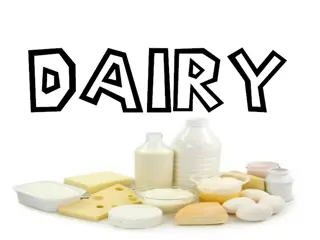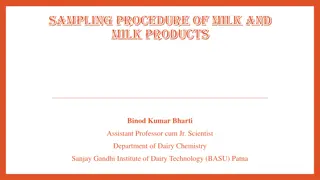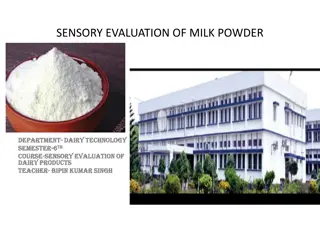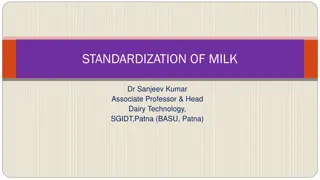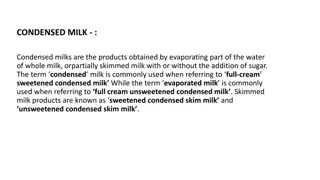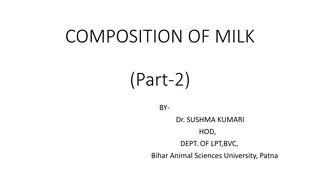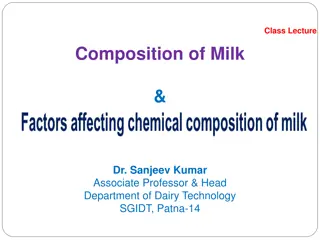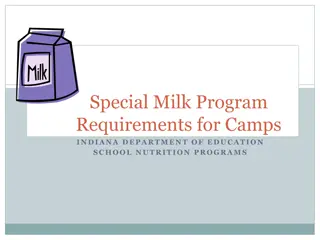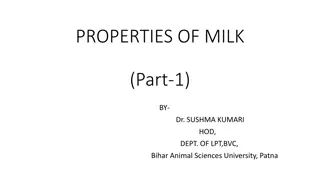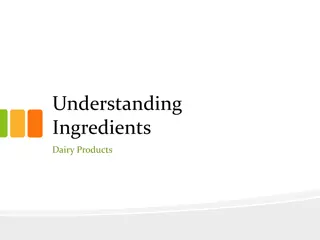Microbiology of Market Milk: Understanding Thermoduric Organisms
Market milk microbiology by Dr. Sanjeev Kumar in dairy technology, focusing on the microflora surviving pasteurization, sources of thermoduric organisms, significance, and types of thermophilic and psychrotrophic microflora. Learn about the impact of various organisms on milk quality.
Download Presentation

Please find below an Image/Link to download the presentation.
The content on the website is provided AS IS for your information and personal use only. It may not be sold, licensed, or shared on other websites without obtaining consent from the author.If you encounter any issues during the download, it is possible that the publisher has removed the file from their server.
You are allowed to download the files provided on this website for personal or commercial use, subject to the condition that they are used lawfully. All files are the property of their respective owners.
The content on the website is provided AS IS for your information and personal use only. It may not be sold, licensed, or shared on other websites without obtaining consent from the author.
E N D
Presentation Transcript
Microbiology OF MARKET MILK Dr Sanjeev Kumar Dairy Technology
Microfloraof Market Milk Microflora of Pasteurized milk Those surviving pasteurization temperature Those entering as post-pasteurization contaminants Thermoduric Microflora:- I. A. M. luteus, M. candidus, M. caseolyticus Associated with insanitation of equipments Micrococci M. lacticum, M liquifaciens Former one is most heat resistant non-sporeformer Microbacterium B. subtilis, B. cereus, B. circulans, B. polymyxa etc. These are aerobic sporeformers invariably present in past. Milk. S. thermophilus, S. faecalis, S .faecium Increasing pH and substituting peptone for tryptone increses recovery of these bacteria Bacillus Streptococcus Lb. bulgaricus, Lb. lactis Fastidious, not encountered frequently in past. milk Lactobacillus Others Arthrobacter spp., Clostridium spp.,Streptomyces spp.
Sources of thermoduric organisms: o Insanitary conditions of milking equipment o Insanitary conditions of pasteurization plant( milk stone formation and improper cleaning of rubber parts) o Repasteurization of returned pasteurized milk. Thermodurics start multiplying at warm stages during second pasteurization Significance: o Due to temperature fluctuations, these organisms produce defects such as sweet curdling, gassiness, proteolysis, bitterness etc. o Under refrigerated storage ,psychrotropic thermodurics like Bacillus and Clostridium spp.
B. Thermophilic microflora They grow pasteurization. Their upper limit for growth is 70 C. Types:- aerobic or facultative anaerobic sporeforming rods constitute majority of thermophilic microflora o Lactobacillus thermophilus o Bacillus spp. like B. stearothermophilus B. thermoacidurans B. calidolactis B. coagulans well during holder method of Sources: o Their count is less in raw milk which significantly increases during holding at high temperature This group represents dairy plant rather than farm contamination Repeated use of improperly cleaned hodling vats Residual milk foam and warm milk in dead ends/vats Repasteurization of returned milk o Increases thermophilic count
Significance: o Under ambient condtions, sporeforming bacilli cause spoilage problems like sweet curdling or bitty cream defects in pasteurized milk. C. Psychrotrophic microflora: Grow at refrigerated temperature(2 -7 C) irrespective of their optimum growth temperature. Most of them are mesophiles, some are psychrophilic Types: divided into two categories Psychrotrophic thermoduric bacteria Gram-positive rods and cocci e.g. Bacillus, Clostridium and Streptococcus. Psychrotrophic bacteria Gram-negative rods e.g. Pseudomonas, Flavobacterium, Alkaligenes, Achromobacter, Acinetobacter
Sources: o first category --> survival during pasteurization o Second category --> post pasteurization contamination o Water supplies may serve as a possible source. Significance: o At referigerated storage(7.2 C or lower) --> gram-negative psychrotrophs outgrow o At 10 C or above --> thermoduric psychrotrophs tend to outgrow o Importance of gram-negative psychrotrophs --> cause number of defects like fruity, rancid, bitter , putrid, roppiness and discoloration etc. o Minimum population required to produce defects are 107/ml
Coliform bacteria This group of organisms refer to aerobic and facultatively anaerobic, sporeforming rods which ferment lactose into acid and gas at32 C within 48hrs in presence of bile salts and dye. Types: Escherichia, Enterobacter, Citrobacter Source: Destroyed during pasteurization. Post-pasteurization contamination. Improper cleaning/sanitization Unhygienic handling practises Water supplies D. Gram-negative, non- Klebsiella and o o Major sources of contamination o o o
Significance: o Unlike water supplies, where their detection is taken as index of faecal contamination, coliform detection in pasterurized milk is taken as index of post-pasteurizartion contamination. o This group is usually traced to dairy plant. o Above 7.2 C, they cause defects like roppiness, gassiness, unclean and medicinal off-flavours and bitterness. E. Pathogenic microorganisms That survive pasteurization --> B. cereus, Cl. Perfringens, haemolytic streptococci and some viruses Through post-pasteurization contamination --> dirty habits of handlers( E.coli, Salomella) or those carried by an unhealthy handler. L. monoctogenes and Y. enterocolitica can multiply even below 7.2 C but these species are heat labile. Improper storage of contamination is equally hazardous. loose milk after such
Microflora of UHT milk Ultra-high temperature is carried out at 135 - 150 C coupled with aseptic packaging. The only microflora survive UHT treatment are bacterial spore of thermophlic bacilli( B. stearothermophilus) mesophilic bacilli and clostridia. Major spoilage organisms in heat processed milk are, B. megaterium( main cause), B. firmus, B. polymyxa, B. coagulans and Clostridium spp. Microorganisms entering packaging practices are usually associated with stagnant water on dairy floors ( Pseudomonas, Coryneform, Micrococci etc). Major defects --> coagulation, bitterness and gassiness. and sometimes to through faulty
Microflora of Boiled Milk In India, milk is boiled to 100 C for brief period before consumption. Boiling kills vegetative forms of all microbes except heat stable enterotoxins esp. of Staphylococci. Post pasteurization contamination can also occur due to improperly cleaned utensils and due to improperly heated portions of milk. Major defects--> off-flavour coagulation and gassiness. Boiled milk should be utilized within 16 hrs, particularly in absence of refrigeration. (proteolytic),




